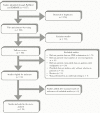Colonization With Vancomycin-Resistant Enterococci and Risk for Bloodstream Infection Among Patients With Malignancy: A Systematic Review and Meta-Analysis
- PMID: 28480243
- PMCID: PMC5414102
- DOI: 10.1093/ofid/ofw246
Colonization With Vancomycin-Resistant Enterococci and Risk for Bloodstream Infection Among Patients With Malignancy: A Systematic Review and Meta-Analysis
Abstract
Background: Vancomycin-resistant enterococci (VRE) cause severe infections among patients with malignancy, and these infections are usually preceded by gastrointestinal colonization.
Methods: We searched the PubMed and EMBASE databases (up to May 26, 2016) to identify studies that reported data on VRE gastrointestinal colonization among patients with solid or hematologic malignancy.
Results: Thirty-four studies, reporting data on 8391 patients with malignancy, were included in our analysis. The pooled prevalence of VRE colonization in this population was 20% (95% confidence interval [CI], 14%-26%). Among patients with hematologic malignancy, 24% (95% CI, 16%-34%) were colonized with VRE, whereas no studies reported data solely on patients with solid malignancy. Patients with acute leukemia were at higher risk for VRE colonization (risk ratio [RR] = 1.95; 95% CI, 1.17-3.26). Vancomycin use or hospitalization within 3 months were associated with increased colonization risk (RR = 1.92, 95% CI = 1.06-3.45 and RR = 4.68, 95% CI = 1.66-13.21, respectively). Among the different geographic regions, VRE colonization rate was 21% in North America (95% CI, 13%-31%), 20% in Europe (95% CI, 9%-34%), 23% in Asia (95% CI, 13%-38%), and 4% in Oceania (95% CI, 2%-6%). More importantly, colonized patients were 24.15 (95% CI, 10.27-56.79) times more likely to develop a bloodstream infection due to VRE than noncolonized patients.
Conclusions: A substantial VRE colonization burden exists among patients with malignancy, and colonization greatly increases the risk for subsequent VRE bloodstream infection. Adherence to antimicrobial stewardship is needed, and a re-evaluation of the use of vancomycin as empiric therapy in this patient population may be warranted.
Keywords: VRE.; bloodstream infection; cancer; colonization; malignancy.
© The Author 2016. Published by Oxford University Press on behalf of Infectious Diseases Society of America.
Figures



References
-
- Humphreys H. Controlling the spread of vancomycin-resistant enterococci. Is active screening worthwhile? J Hosp Infect 2014; 88:191–8. - PubMed
-
- Uttley AH, Collins CH, Naidoo J, George RC. Vancomycin-resistant enterococci. Lancet 1988; 1:57–8. - PubMed
-
- Ramsey AM, Zilberberg MD. Secular trends of hospitalization with vancomycin-resistant Enterococcus infection in the United States, 2000–2006. Infect Control Hosp Epidemiol 2009; 30:184–6. - PubMed
-
- Centers for Disease Control and Prevention. Biggest Threats Available at: http://www.cdc.gov/drugresistance/biggest_threats.html Accessed 1 September 2016.
LinkOut - more resources
Full Text Sources
Other Literature Sources

